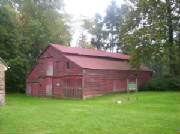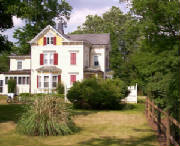|
|
|

|
|

|
| Old Barn near Lambertville, NJ |
|

|
| Old Bridge Victorian House - Old Bridge, NJ |
|

|
| Historic Colonial House - NJ |
|

|
| The Red Mill in Clinton NJ |
New Jersey is filled
with some very old places! Some are seen as foundations, representing all that is left of what once was. From the first
Native American settlements to the colonists and beyond, New Jersey is teeming with history. The
first European settlers in New Jersey were Dutch, Swedes and Finns. Verrazzano was the first to sail up the Jersey shoreline
in 1524. He was followed by another explorer Henry Hudson in 1609 looking for a new trade passage to the Pacific Ocean. These
European explorers were the first to encounter the local native population known as Lenni-Lenape, “the original
people“. These hunter/gatherer tribes lived throughout New Jersey and the surrounding area. They were known by
their language, tribal structure, and regions such as: the Raritan, Manasquan, Hackensack, Ramapough, and Rankokus. Lenne Lenape Indians in New Jersey The Lenape’s intimate knowledge of the land made for an ideal trading relationship with
the Dutch who bought and traded with their settlements along the Hudson, the Raritan and Delaware River communities in New
Jersey. The Swedes also had settlements on the lower Delaware River known today as Swedesboro. These new colonies were called:
New Netherland and New Amsterdam. In 1664, New Jersey became an English colony as the result
of the Dutch/Anglo Wars. The British claimed the land from the Dutch, and the state was divided into East Jersey and West
Jersey. Unlike the north and south parts of the state that we commonly refer to today, New Jersey of the 1600s and 1700s was
divided lengthwise. In 1738 England transferred power to New Jersey royal governor, Lewis Morris. Eventually
the colonists decided to overthrow the British government, which lead to the Revolutionary War. Washington's famous crossing
of the Delaware River from Valley Forge to Trenton was on December, 25th 1776. This led to the crucial battles of Trenton,
Monmouth, and Princeton that followed and solidified New Jersey's role as a key player in the Revolutionary War. Here
is a great link that includes a video re-enactment of the Revolutionary War in New Jersey - Jersey Blues Diversity has always been a factor in New Jersey’s population.
First the Dutch, Swedes, and Finns followed by the British. Next came the Scottish, German and Irish, followed by the Italians,
Polish, and Eastern Europeans. In the 1800s canals and railroads were built to transport goods including flowers and produce
to Philadelphia and New York City. New Jersey remained mostly rural until the mid-1900s and the advent of the highway system.
Today much of the state is still rural with almost 20% of New Jersey's lands covered by farms. Colonial era architecture can be found all throughout New Jersey. Victorian
architecture is prominent in Cape May. Many towns have historical societies that have preserved some places built as early
as the 1600s. There are also historic farmsteads, such as the Van Campen's Inn. Many NJ towns have historical societies that
have preserved these places and opened them to visitors. New Jersey’s
long history of being a state of interest includes being the first state to ratify the Bill of Rights, and unearthing the
first dinosaur fossil; Hadrosaurus, found in North America in a farmer’s field in Haddonfield, NJ. New Jersey also is
the home of the legendary pinelands Jersey Devil and legends of Captain Kidd’s buried treasure, believed to be lying
in the depths of the ocean along the Jersey shoreline.
|
|